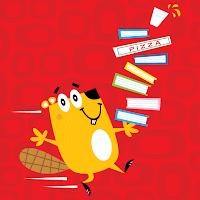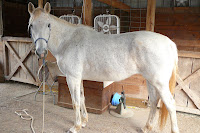
Willing upward transitions were a huge struggle for me. As a somewhat fearful rider on a very green horse, I lacked the skill and confidence to teach Cricket what I really wanted. It has taken years to get where we are now - a rider willing to ask and a horse happy to respond.
It's been a rough journey. So many of the things I did caused Cricket to hate upward transitions as much as I feared them. Usually my requests were met with pinned ears, a swishing tail, crow hops or full blown bucking.
I think the main problem with an unconfident rider starting a green horse is that we don't feel comfortable to go with what the horse offers. And the horse can quickly learn that moving out is not a desirable thing. This is what I taught Cricket.
So how did I get from where I started to where I am now? Sometimes I don't exactly know. But here are some things that helped me feel confident and in control and at the same time, allowed Cricket to find freedom in
forward.
I learned not to squeeze her with my leg. Squeezing caused her to buck.
I learned not to over-exaggerate my request. All that did was upset her and confuse her.
Most importantly, I learned to cue her first on ground patterns and then under-saddle patterns. Here is where our big breakthrough came.
Groundwork:
On the ground, I found two major keys to unlocking our upward transitions: vocal cues and patterns.
Voice Cues
I know PNH is not big on voice cues. I get it. I also understand why. When we're moving our mouths, we're not always aware of our bodies. But I learned this from Linda at the ISC in 2005. Introducing a smooch or cluck for an upward transition gives you another step before applying physical pressure. For an introverted horse, that means more time to think. So in asking for an upward transition, introduce a cluck or smooch with phase 1.
Patterns
Dan Thompson said anything can be a pattern. I believe him. To help Cricket understand "upward transition" vs. "go faster" I used a variation on the circle game to get my point across.
I simply placed a cone at 12 o'clock and the game was "transitions at the cone." Depending on where you are with your horse, the game can be adapted. Basically, it's on-line/liberty question box. Ask your horse for a change at the cone and then leave him alone when he complies. If he breaks gait, just leave him alone until he comes back to the cone and ask again.
It's a game; a puzzle to be solved. And it works for every horse. And you can build your expectations.
The game can be expanded to assist in maintain gait by adding more cones at 6 o'clock and then at 3 and 9 o'clock. Start with 12 and 6, asking for the upward transition at each marker, allowing the horse to break gait in between. If he is still struggling, add the next two markers, asking for the upward transition at each marker. Eventually the horse finds it easier to maintain than shift up and down.
Works great for the human because it stops us from micro-managing or getting frustrated. Each cone is an opportunity and there's no nagging in between. The space between the cones is true neutral.
Under Saddle
In riding, the key was relaxation in motion and patterns.
Relaxation in Motion
There is nothing worse than an emotional and tense horse. The horse cannot learn, he cannot feel comfortable and it's just an accident waiting to happen. For Cricket, I needed to teach her to relax in motion. This was almost automatic on the ground but it needed to transfer to under saddle. Mostly this came from just paying attention, working on my riding dynamic and moving long enough to cause her to make a change.
Most of our rides were based on survival. Probably for both of us. I was just happy when I could end a ride at my choice rather than feeling like I needed to get off. Not exactly a harmonious partnership.
Once I got saddle fit working and some improvement in my balance and posture, the next part was just moving long enough to let her blow and release the tension. At first I'd transition down to the halt when she'd offer relaxation. Just so she knew that was the key. Later, I'd ask her to continue to move. Eventually she was offering less tension. She's not 100% relaxed 100% of the time. But neither am I. The key is noticing and making it important.
Patterns
There are those pesky patterns again. For me, the key pattern was the question box. For others it may be corners or point to point. The important thing is the pattern and allowing it to work.
In my reflections on riding Cricket I came to two main conclusions: causing her to trot took focus and intention; when cantering was her idea, it was an effortless transition. So I needed to help her understand my intention and cause it to be her idea too. The question box worked for me because it gave me the idea of control. Of course cantering on a bend is
infinitesimally harder than cantering a straight line. But the infinity of the circle helped me feel more relaxed.
From there, it was just repeating the pattern until it worked. Coming through the box, I asked Cricket to canter and then just committed to riding whatever she did. It took 6 or 7 repetitions for her to go, "Oh, you meant
canter! Why didn't you just say so in the first place?" From there on, it's been a fairly simple matter. I'm now cantering her on both leads, on the rail, around the arena and out in the paddock.
THE BIG REALIZATION
Even more important than any of the things I did was
The Big Realization. And you know what that is? It's finally understanding that it doesn't matter what I cannot do with her or what we haven't yet accomplished. My focus needs to be solidly on all the wonderful things we can do. All the ways in which Cricket reveals her fabulosity
every time I'm around her.
Falling in love with how perfect a horse she is at every moment is so liberating. I walk away from every play session with a list of
WOW! moments. Things that just make me smile.
 I've learned not to say "it cannot get any worse." It can. And it usually does.
I've learned not to say "it cannot get any worse." It can. And it usually does.



 Yesterday I had my first "hands-on" experience with Centered Riding. I've been introduced to some of the concepts when I took lessons with my friend Margenia. I was vaguely aware of it as a cross-discipline approach to riding. But truthfully, I had no idea just how fantastic it could be.
Yesterday I had my first "hands-on" experience with Centered Riding. I've been introduced to some of the concepts when I took lessons with my friend Margenia. I was vaguely aware of it as a cross-discipline approach to riding. But truthfully, I had no idea just how fantastic it could be.






